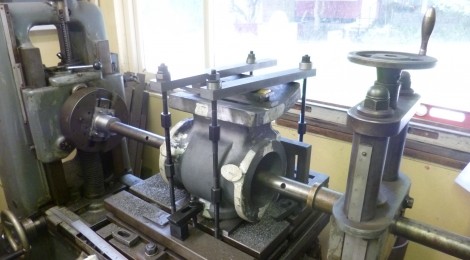
A boring day for Samson…
Dave Young has spent another day in a private workshop boring Samson’s cylinder block. The method of ‘boring’ is often referred to in the railway press, particularly with regard to locomotive cylinders, so I thought a few photos might explain what has actually taken place on Samson.
Below: This view shows the cylinder block tightly clamped and aligned to the bed of the Kearns boring machine that is being used for this job. Note the drive at the left and the ‘steady’ to the right, this carrying the end of the boring bar itself. The cutter is set up on the bar in a location to allow for full travel of the cylinder block across it – the cutter rotates but stays put, whilst the cylinder block is slid along – the table it is mounted on is driven with a setting to enable various speeds of travel to be set.
Below: It can’t be over estimated just how much preparation and measuring is carried out before even switching the machine on. Here Dave checks the alignment once more having made the first initial pass.
Below: This view explains more clearly than words what is taking place! Looking through the cylinder bore towards the driving chuck on the boring machine, the cutter can be seen in the four o’clock position. As can be seen, it rotates around the shaft and cuts the grey iron of the cylinder block using the removable tip. Several passes are made, the cut not being carried out in one go. Also clearly visible is the steam passageway within the cylinder wall. By fitting a liner to the block, which will be machined to fit the bored diameter, this will turn this passageway into a cavity – saving on tricky coring and the casting stage and enabling a greater deal of control in the machining stages. This is not the usual method, though locomotive cylinders are often bored over-size when worn and a liner fitted to return the designed dimension – Dunrobin’s original cylinder block has been treated in this way in the past.
Below: The cutter reaches the end of its penultimate pass.
Below: The beginning of the final, finer, pass – done at a slower travel rate (0.6 inches per minute rather than 1 inch per minute) – note the line of cut just visible to the left of the swarf in the bore.
Below: Once the bore was completed, the second cylinder end was faced (the other end having been done to the same setting as the bore, to ensure accurate alignment). There are still some machining jobs to complete, not least the saddle which will be contracted out due to the size of the ‘throw’ – being two feet in diameter. Its great progress and Dave is now looking at the liner itself, which will require a large amount of machining to get it both a pressed tight fit into the block as well as having an inside dimension and finish suitable for the piston and rings to travel along. I also took some film of the boring process, which will appear in a short film on the project so far in due course.













Interesting photo’s , not being an engineer myself it’s always great to see how tasks such as this are performed.
cracking photos and explination of whats happening I luve all things mechanical and old brill